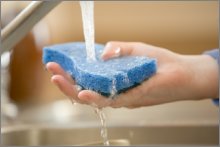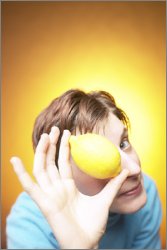How NOT to Clean Your House:
Five Things You Should Definitely Avoid
by www.SixWise.com
While you may rather put off thinking about a truly clean
home for another month or two, when it's time for spring
cleaning, now is as good a time as any to take stock of
what a winter's worth of holiday traffic, snow- and salt-covered
boots, and, for some of us, several months without an open
window can do to your home.
|

Be sure to replace your existing dish rags and kitchen
sponges with PerfectClean
terry cloths, as the old common dish rags and sponges
are two of the most germ-laden items found in the home,
according to recent studies.
|
Dirty, dusty, germy, stuffy and stinky may all come to mind.
But before you don your rubber gloves and grab your pine-fresh
cleanser, there are some things you should know.
If you're not careful, cleaning your home could actually
be hazardous to your, and your family's, health. Here are
the tips you need to NOT do in order to keep your home clean,
fresh and toxin-free.
1. Do NOT leave your home smelling like a lemon, an orange,
or a pine tree.
Researchers from the University of California-Berkeley and
Lawrence Berkeley National Laboratory analyzed 21 household
cleaners and air fresheners and found that many -- especially
those with pine, lemon or orange scents -- emit excessive
levels of toxic pollutants.
Six of the products contained ethylene-based glycol ethers,
which are classified as hazardous air pollutants by the U.S.
Environmental Protection Agency. Meanwhile, 12 products contained
terpenes, which are found in the pine, lemon and orange oils
used to give cleaning products their "clean" smells.
Terpenes have been found to react with ozone to produce a
variety of toxic substances.
|
Enviro-Rite Non-Toxic Cleaning Line:
Safe Cleaning Products for a Healthy Home
 Unlike
most cleaning solutions on the market that contain harsh
detergents, synthetic chemicals and harmful additives,
the Enviro-Rite cleaning line is completely safe --
they contain no hazardous ingredients, petrochemicals,
perfumes, dyes or animal byproducts. Unlike
most cleaning solutions on the market that contain harsh
detergents, synthetic chemicals and harmful additives,
the Enviro-Rite cleaning line is completely safe --
they contain no hazardous ingredients, petrochemicals,
perfumes, dyes or animal byproducts.
And, they're incredibly effective for all of your cleaning
needs:
-
Enviro-Rite Carpet & Upholstery Cleaner: Intended
for use on both carpet and upholstery, EnviroRite
Carpet Cleaner is an excellent vegetable-based cleaning
concentrate that replaces all petroleum-based formulations.
-
Enviro-Rite Dishwashing Liquid: Kitchen Sink Dishwashing
Liquid makes quick work of dirty dishes and contains
soy's natural moisturizing qualities to make washing
dishes smoothing to your hands!
-
Enviro-Rite Spot Lifter: Spot Lift is an excellent,
ready-to-use carpet and upholstery cleaning solution
that makes house cleaning easy, effective and hazard-free!
-
Enviro-Rite Glass & Plexi Cleaner: Clearly
Clean is a ready-to-use, high performance cleaning
solution made with naturally occurring, renewable
ingredients.
Check
out the entire Enviro-Rite Non-Toxic Cleaning Line Now!
|
So ditch the fragranced, artificial cleansers: A truly clean
home shouldn't smell like anything.
2. Do NOT use dust rags and mops that simply push dirt
around.
Most cleaning cloths simply push dirt from one area of your
home to another, which is just plain gross, not to mention
a waste of your time. Instead, try the PerfectClean
line of terry cloths, mops and dusters.
PerfectClean cloths are made of ultramicrofibers that are
naturally positively charged, while contaminants are negatively
charged. That means that wet or dry, and unlike the old common
types of rags that simply spread microscopic contaminants
around when you wipe with them, PerfectClean cloths hold fast
to everything they pick up!
3. Do NOT use chemical cleaners.
Did you know that using cleaning sprays and air fresheners
at least once a week can increase
your risk of asthma by 30-50 percent? It can, so why expose
yourself to this risk?
Instead, opt for PerfectClean
cloths, dusters and mitts for all of your cleaning needs.
PerfectClean terry cloths contain patented built-in antimicrobial
protection and are made of ultramicrofibers that are only
3 microns in size, which is even smaller than many bacteria.
Because of this unique ultramicrofiber construction, you can
reduce the amount of chemical cleaners you use, or even eliminate
them altogether.
So, unlike ordinary cleaning rags and sponges, you don't
need to use chemical cleaners to achieve the deepest clean,
which makes them perfect for anyone who's looking to keep
toxic cleaners OUT of their home.
|

If you want your home to be lemony fresh, ditch the
toxic lemon-scented chemical cleansers and pick up a
real lemon -- it's a natural deodorizer. Rub them on
your cutting boards and put the peels (chopped up into
small pieces) into your garbage disposal to freshen
it up (you can also use grapefruit, lime or orange peels
for this purpose).
|
If you choose to use cleaning products, you can opt for natural
varieties such as Enviro-Rite. Enviro-Rite
has an excellent line of safe cleaning products -- they
contain no hazardous ingredients, petrochemicals, perfumes,
dyes or animal byproducts, and they have products for all
of your cleaning needs, from carpet and upholstery cleaner
to spot lifters.
4. Do NOT use oven cleaner.
Ethers, ethylene glycol, lye (sodium and potassium hydroxide),
methylene chloride, petroleum distillates and pine oil are
just some of the toxic
ingredients that make up most oven cleaners.
Not only is it hard to avoid breathing in vapors when using
oven cleaner, the product is corrosive to your skin and eyes,
and, when inhaled, to your internal organs.
Instead of using oven cleaner, your best bet is to opt for
a self-cleaning oven so oven cleaners are not necessary. You
can cut down on their need also by putting a foil-lined cookie
sheet under foods to catch drippings, and cleaning spots right
after the oven cools (before baking them on again). If you
use oven cleaner, be sure to use heavy rubber gloves, an apron
and chemical splash goggles.
Better yet, for a safe oven-cleaning solution, sprinkle baking
soda on the dampened oven surface, let sit, then scrub with
steel wool.
5. Do NOT underestimate the power of natural cleaning
supplies like lemons, baking soda and vinegar.
Check out Nine Tips to Get Rid of Bad Smells in Common
Household Locations to find out how to get your home smelling
fresh and clean, using all-natural items that you may already
have around your house.
Recommended Reading
The
Five Key Areas of Illness-Causing Germs & Toxins in Your
Home
Groundbreaking
New Study Finds Household Cleaners & Air Fresheners Can
Pose Serious Health Risks
Sources
UC
Berkeley News May 22, 2006